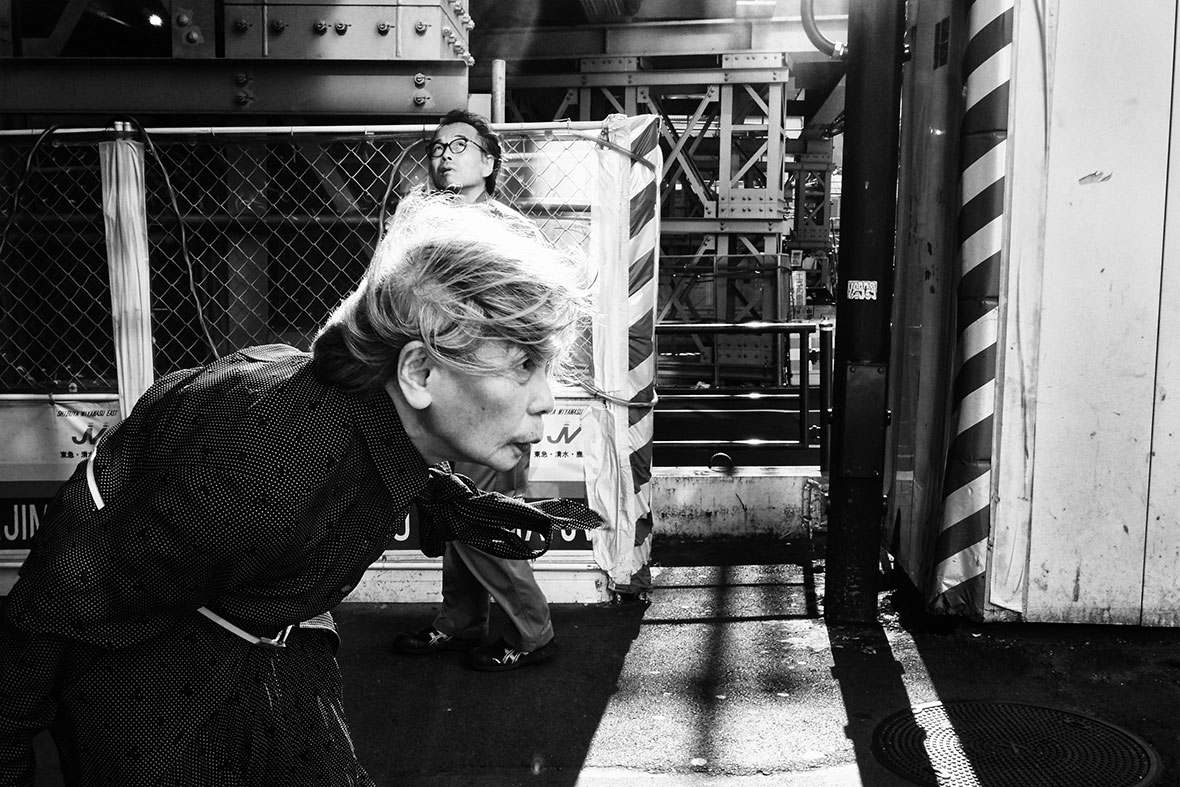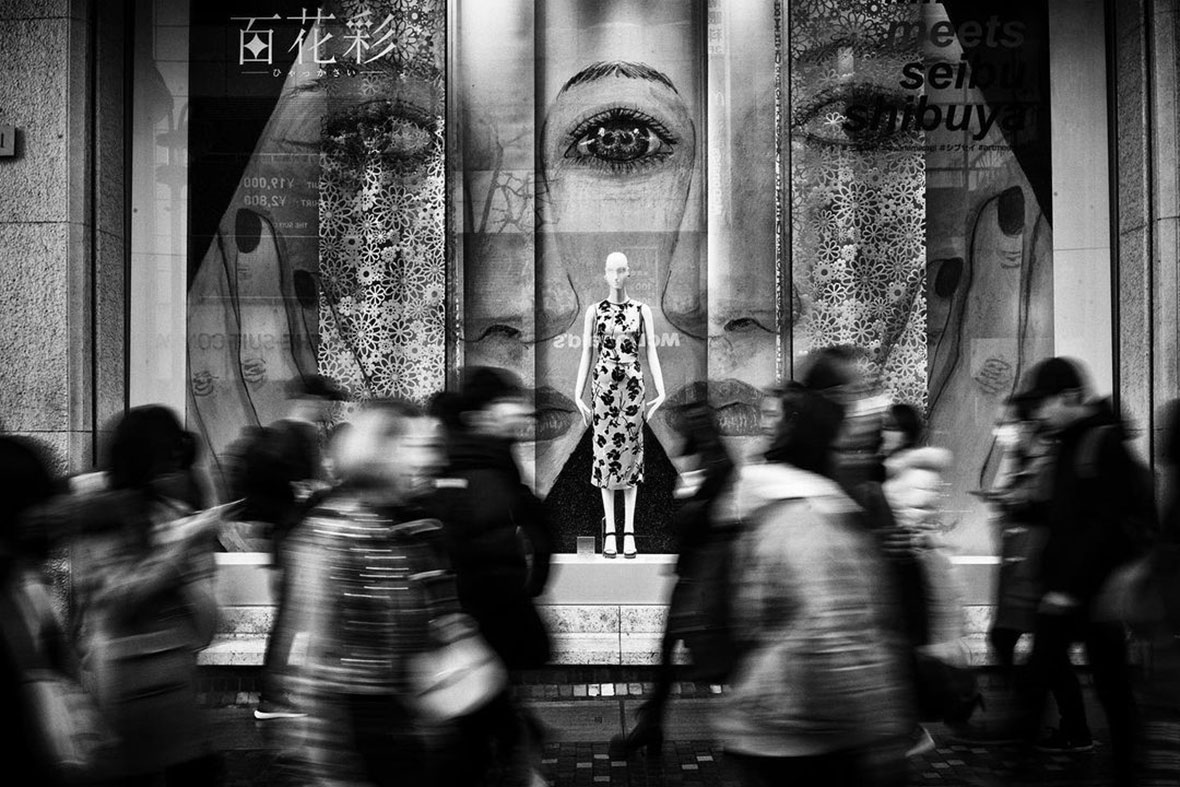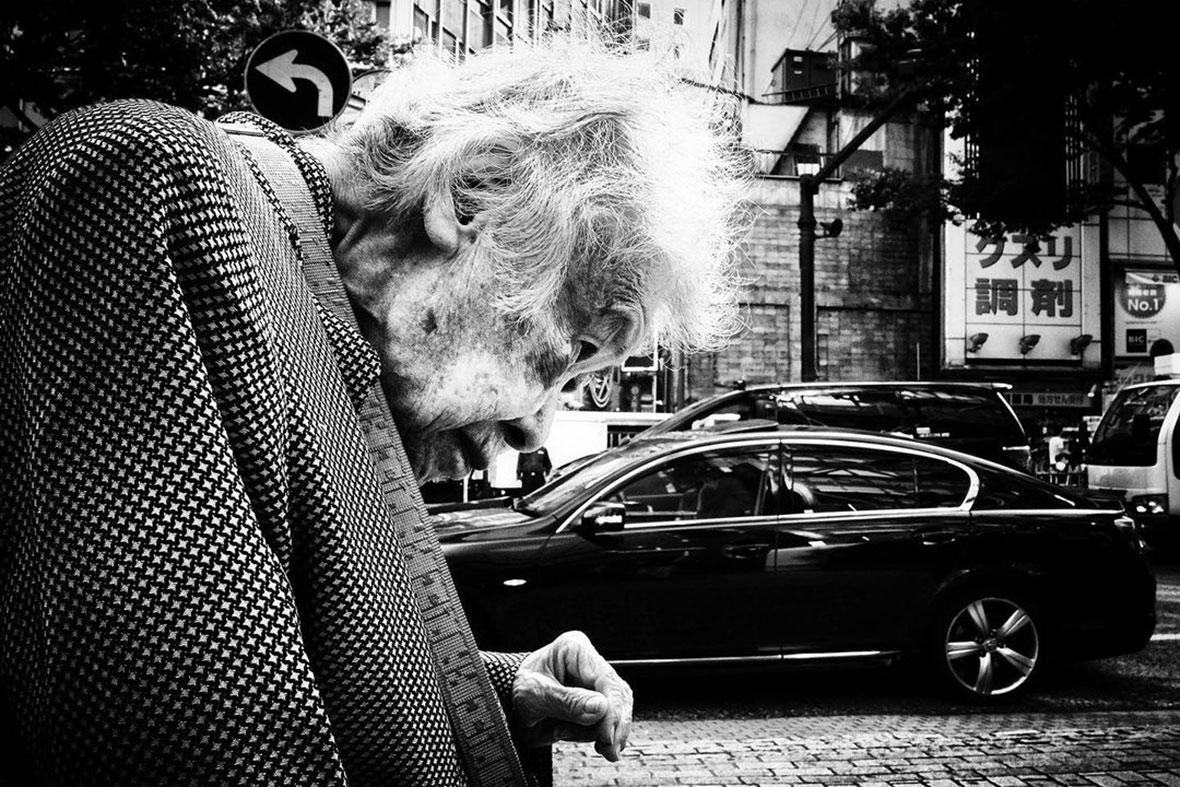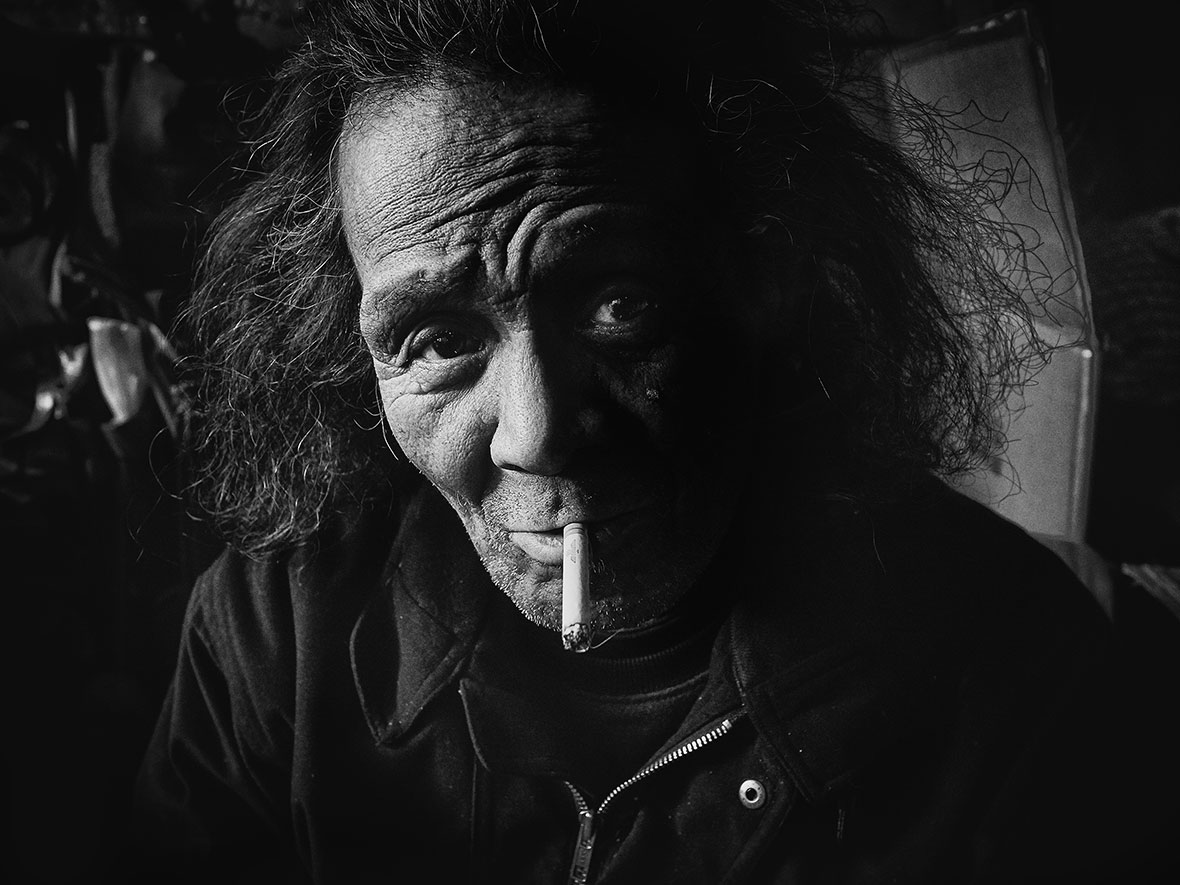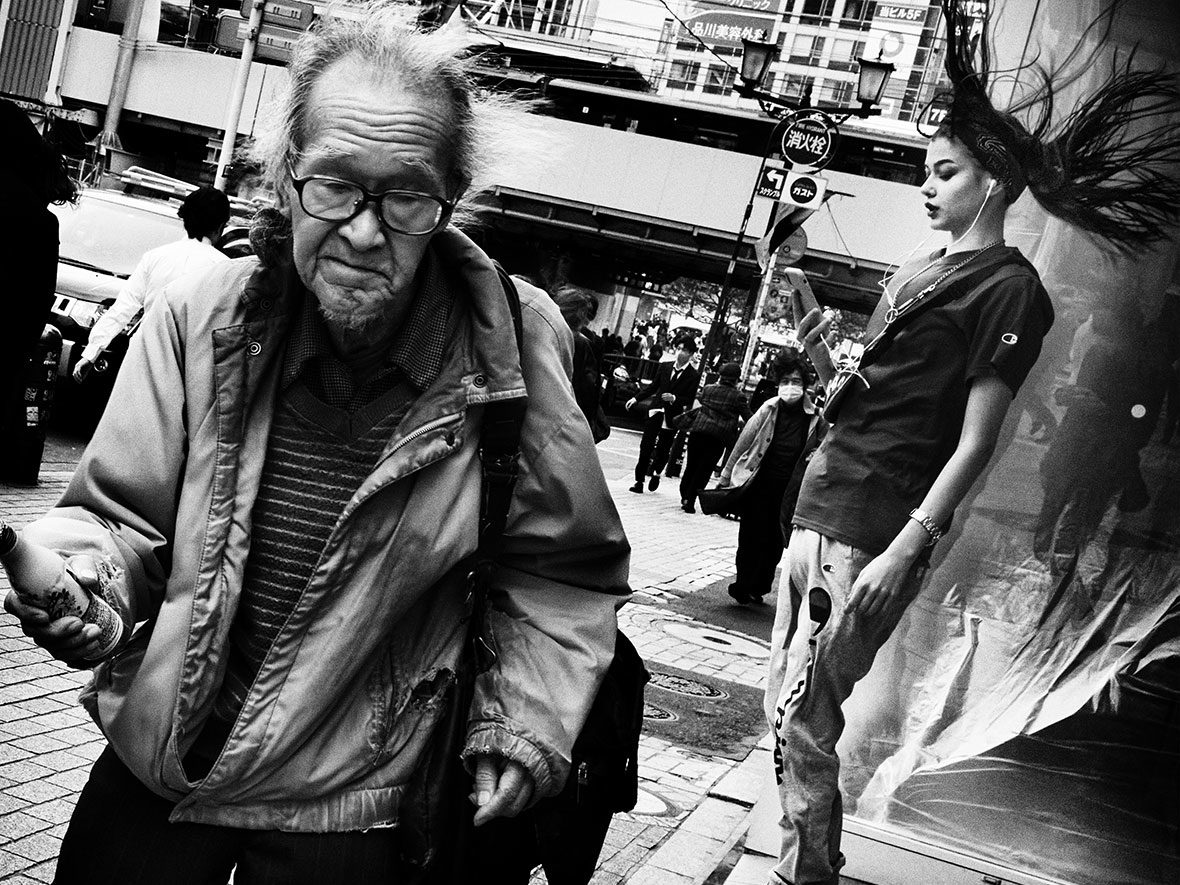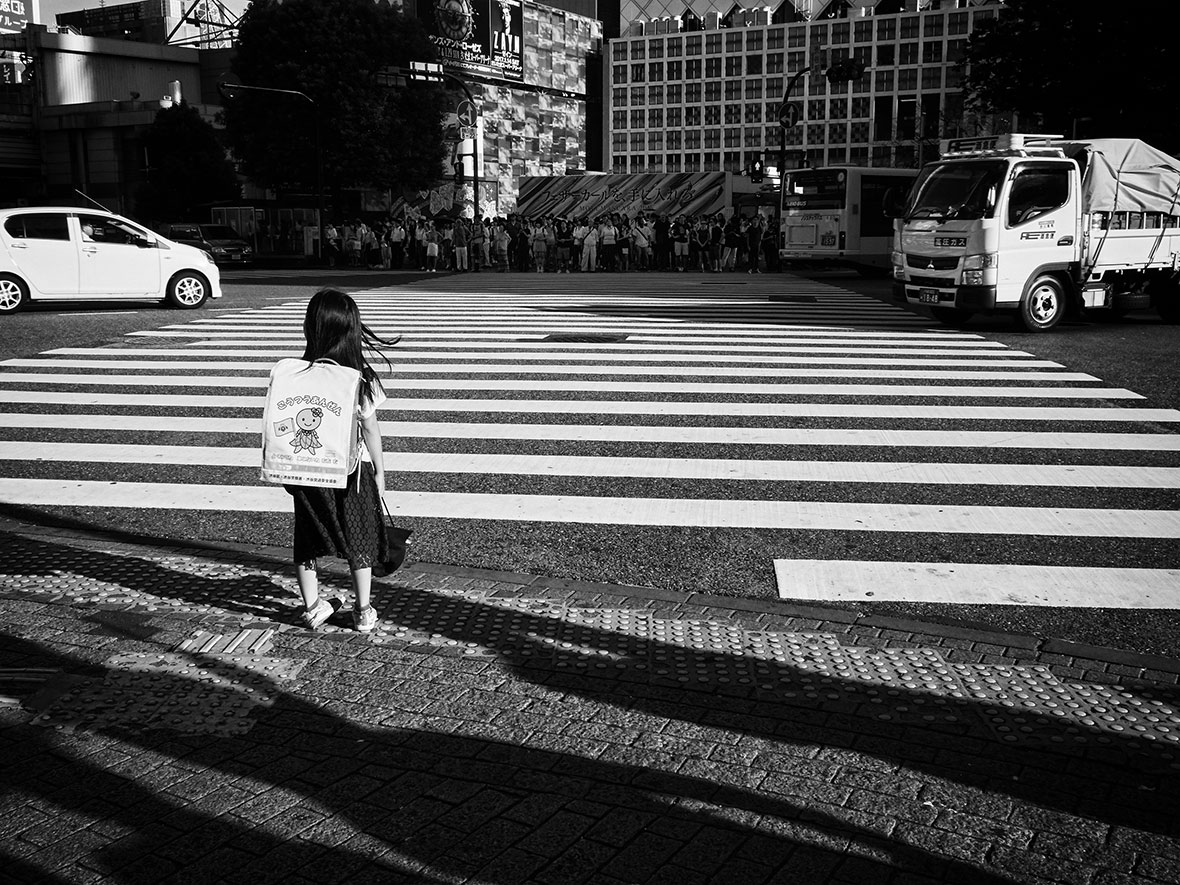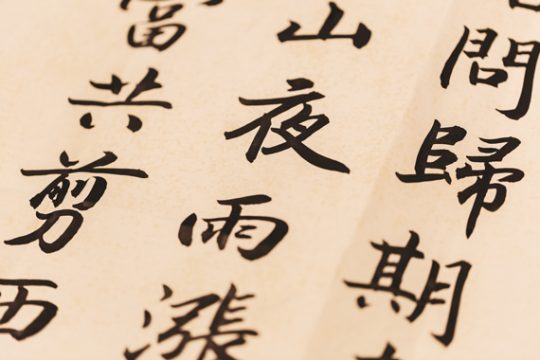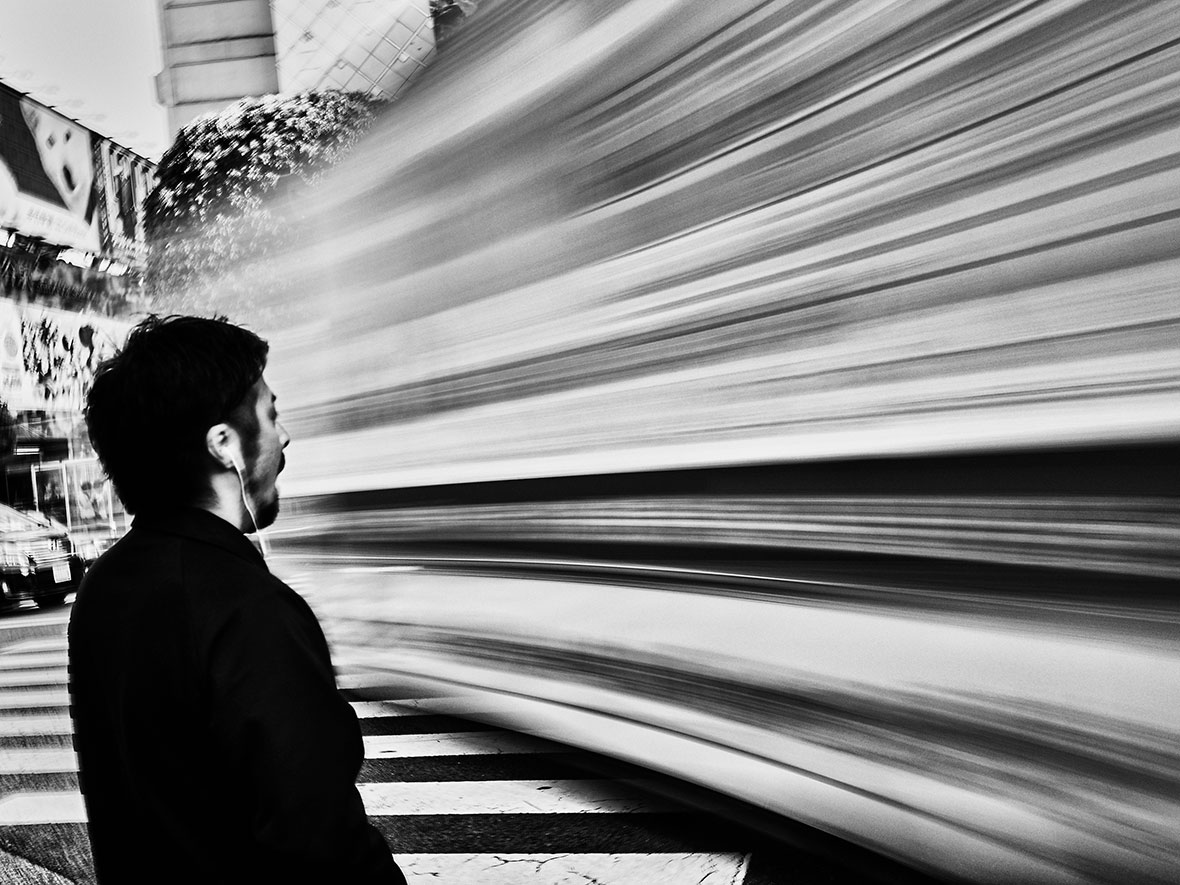
A bus screams past a pedestrian in a blur of white and black lines. As it turns into an intersection, its hovering lines cut across the blocky lines of a crosswalk, seemingly creating a new dimension. Meanwhile, the man simply yawns, wholly unimpressed, his shadowy profile jumping out starkly from the white lines swirling around him. This is the work of Shinya Kawaoto, a portrait-focused street photographer from Japan who shoots exclusively in black and white.
公车从男子身旁呼啸而过,留下糊了的黑白色线条,仿佛来自超现实的维度。与之对应的,是路口等待的男子,一副漫不经心的样子。他身上的深色衣服,与周遭线条,将整幅画面的色彩层次进一步加强。这张照片是来自日本街头摄影师川音真矢(Ash Shinya Kawaoto)的拍摄,他专注于人像摄影,且只拍摄黑白照片。
The sense of contrast—present in both his interplay of shadow and highlights as well as the characters that seem out of place in the settings—is a prominent feature of Kawaoto’s photography. It’s buttressed by a steadfast attention to energy, the creation of surreal settings, and puzzle-like compositions. His subjects display poignant and deeply personal feelings at emphatic moments, and the silvery glint of blacks, whites, and grays shine like precious metals.
从高光和阴影的强烈对比,到与周围环境格格不入的人物神情,强烈的反差感是川音真矢摄影作品的突出特点。虽是黑白照片,但他的作品始终充满活力、超现实感的环境塑造以及出其不意的构图想象力。在照片定格的瞬间,镜头下的人物往往流露出极其个人的情绪,让人印象深刻;而周遭的黑色、白色和灰色则如同视觉的利刃,使整幅画面熠熠生辉。
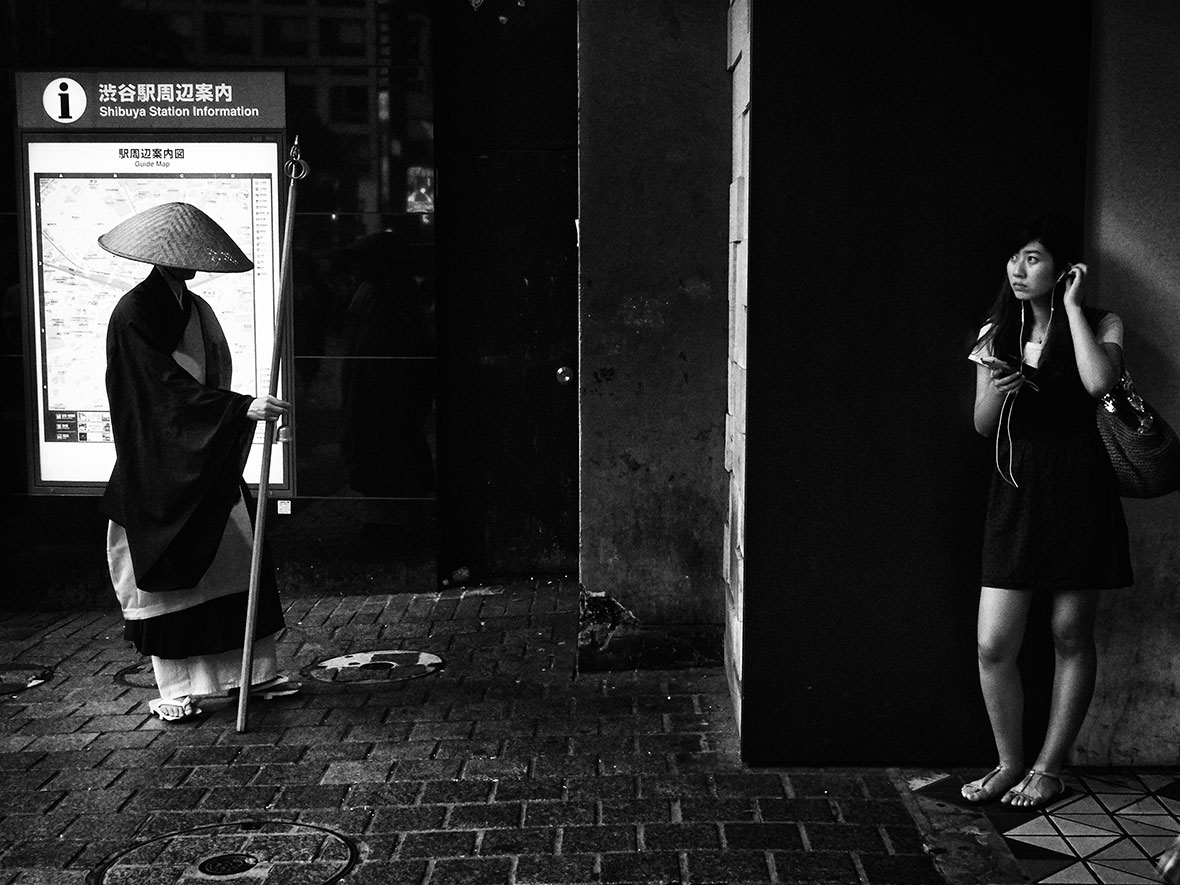
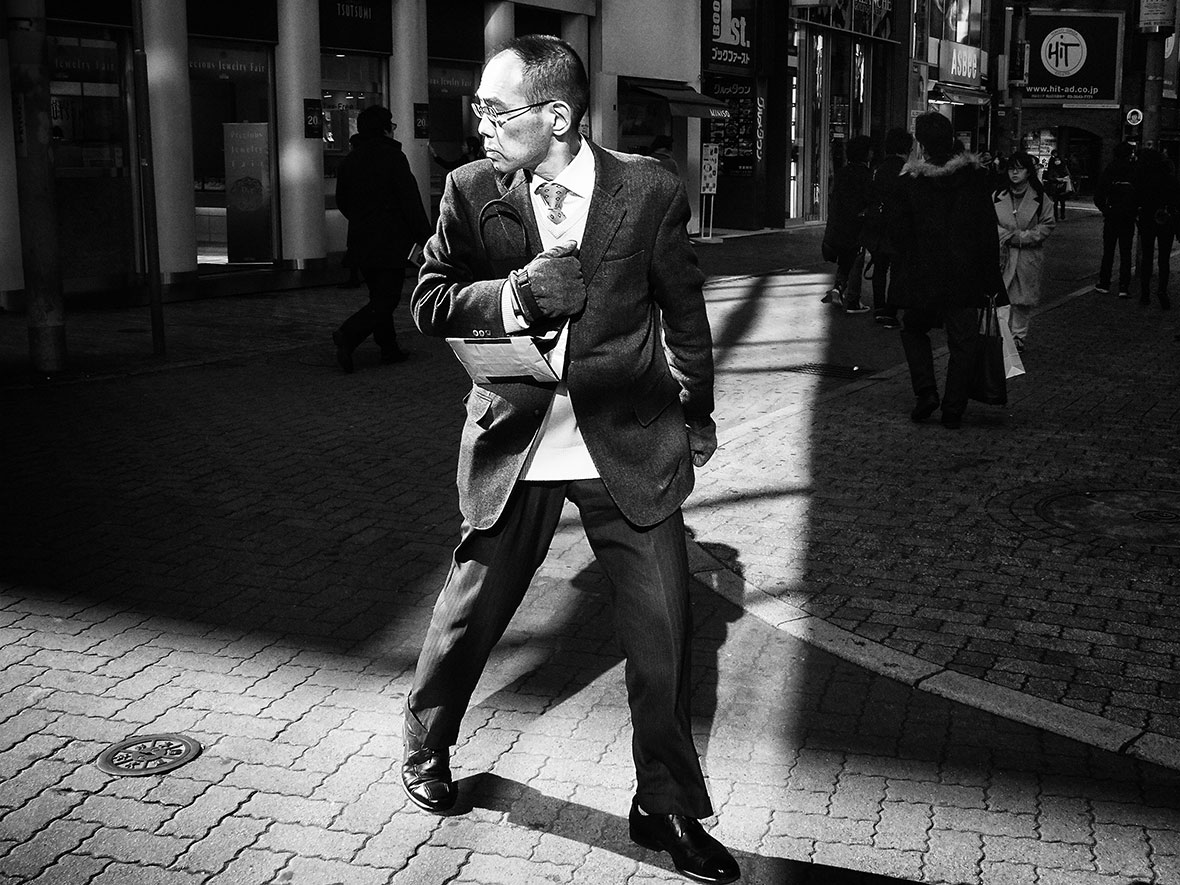
Kawaoto is invested in people, especially their faces. Whether they’re elderly or adolescents, tourists or businessmen, he likes to get right up close, his camera right under their nose, their profile jutting sharply out from their settings. He forgoes the use of color to tame the noise of the busy Tokyo streets, famous for their kinetic lights and flashing signs. This funnels the viewer’s eyes straight towards his subjects. But the city is always present, patiently waiting in the background to be discovered, confident it won’t be forgotten. It’s a supporting cast member; secondary but important.
Taking photographs of strangers can be a tricky thing. But he says people in Tokyo are generally very shy and don’t complain, while tourists are usually fine with being photographed if asked. “I’ve been warned by people to delete my pictures, but it’s never escalated to the point of an argument,” he laughs. “When I tell them the purpose of my pictures, they usually agree to the shot.”
川音真矢专注于人物拍摄,尤其是人物面孔。无论男女老少,游客或上班族,他喜欢把镜头“怼”到他们脸上,让人物的光影从周围环境中脱颖而出。为了隐去眼花缭乱的东京街道,他放弃颜色,将观众的注意力引向人物。但城市的身影也从不缺席,静静地等待被镜头捕捉的时刻。在他的照片里,城市是配角,人物情绪被放在首要位置。
拍摄陌生人照片并非易事,川音真矢也表示,东京人通常比较害羞,而游客在这方面则更加随意一些。“也会有人要求我删除照片,但从来都不会升级到争吵的地步,”他笑着说,“在得知拍摄的意图后,很多人并不会拒绝。”
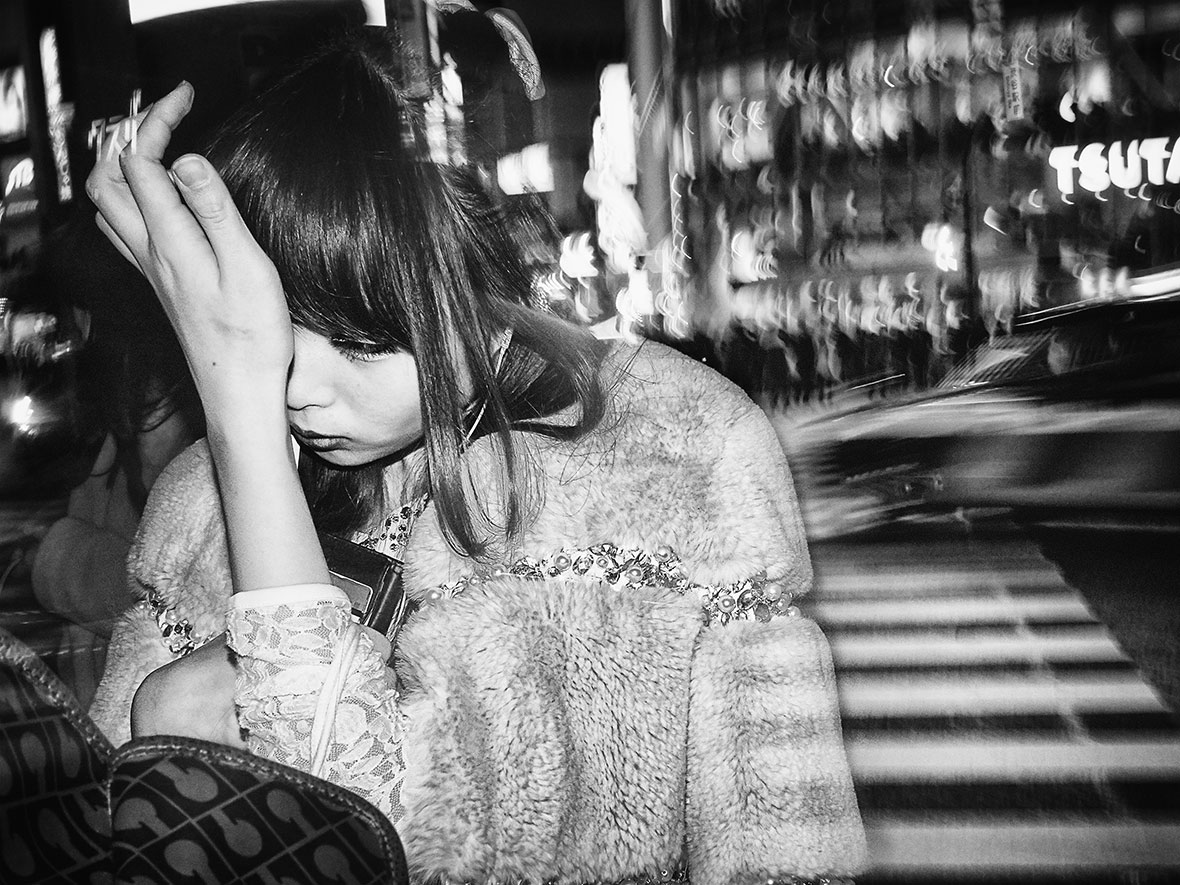
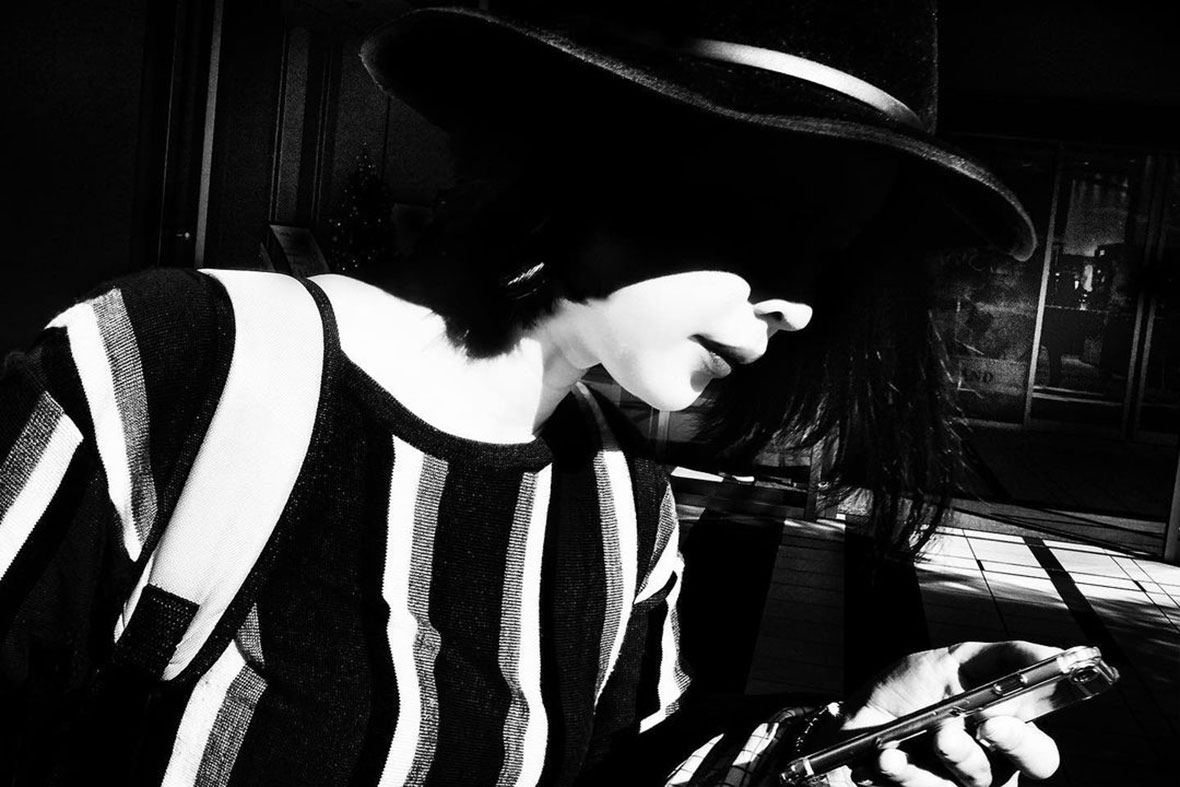
Kawaoto, who’s lived in Tokyo for the last 20 years, started shooting portraits as a hobby for a change of pace from his routine days working in the IT field. One day he took his camera out to Shibuya on a whim and fell in love with the charm of the city when viewed through the lens. “Street photography is a record of the city,” he says. “Tokyo is constantly changing I think it’s important to document this in my photographs.” He paired that with his interest in portraits, positioning people in candid postures as his focal point. “These people are part of the city, they make it what it is.”
川音真矢在东京生活了 20 年,刚开始拍摄人物肖像时,他只是想把摄影当作自己 IT 工作之余的一门爱好。直到一天,他带着相机横穿涩谷,猛然陷入都市的风采之中。“街头摄影是一座城市的记录,” 他说道,“东京在不断变化,我觉得用照片来记录它还蛮有意义的。”加上自己对人像摄影的兴趣,他决定用镜头定格人们在生活中的真实瞬间,“人是城市的一部分,是他们在塑造着这座城市的面貌。”
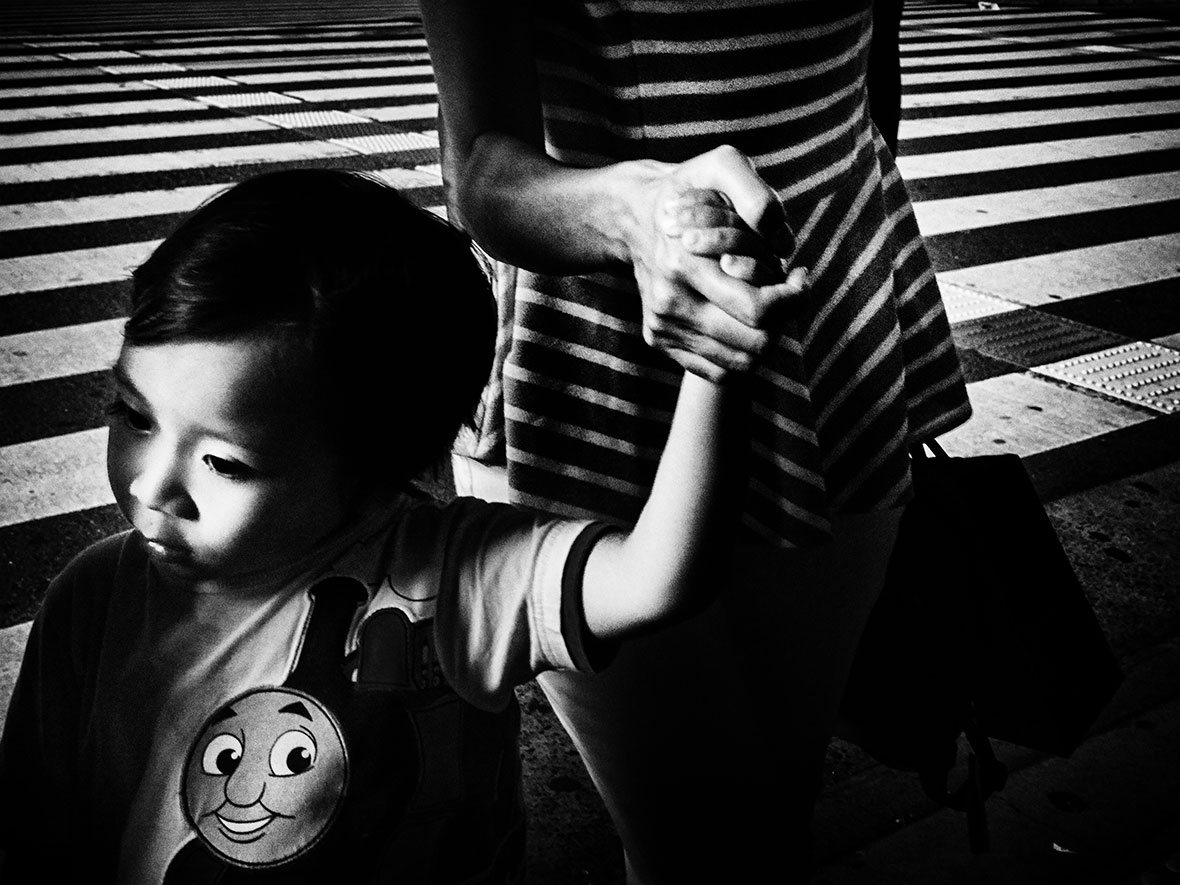
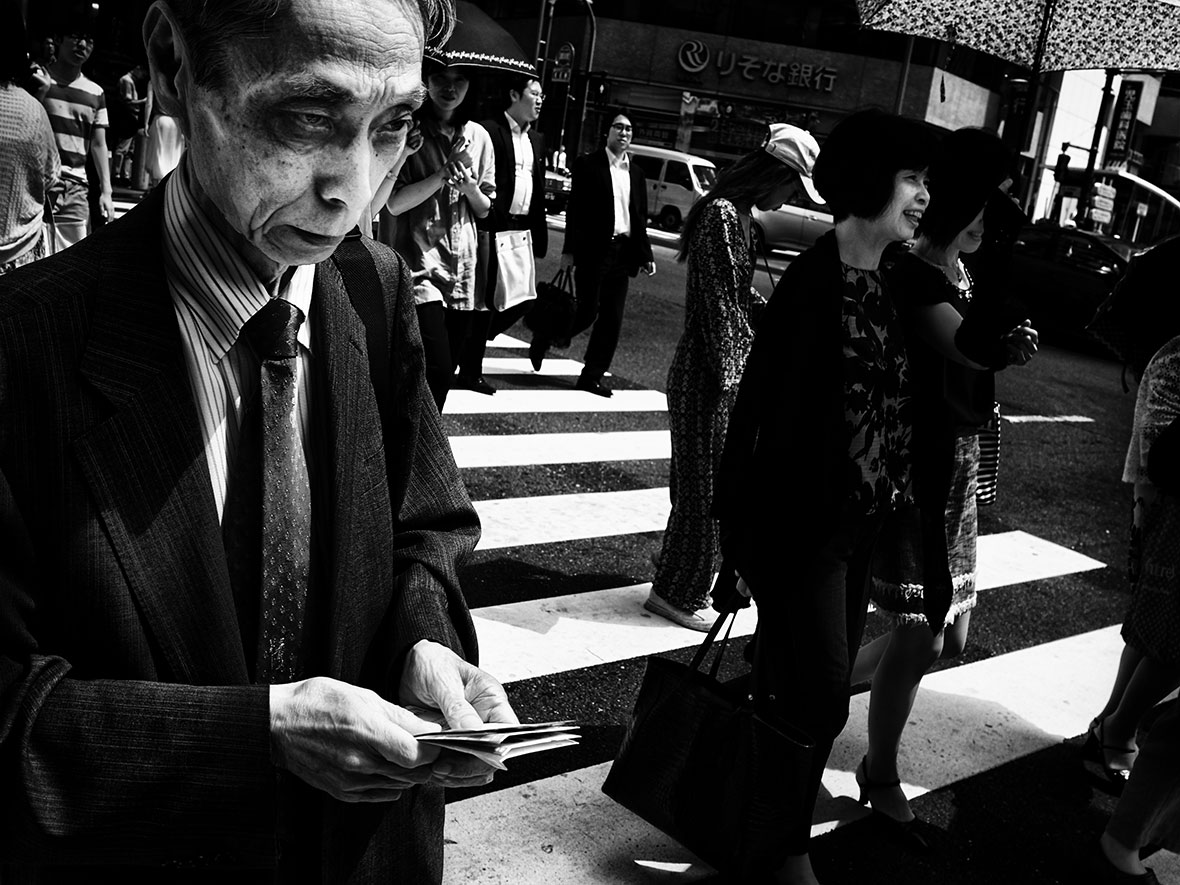
Everything in the frame is kept in focus by setting the aperture for a wide depth of field. This way, a background of sun-soaked tarmac and bright smiles can contrast better with the sickly, elderly man in the foreground. Or it captures the isolation of a little girl waiting alone at a broad intersection, totally separated from the distant crowd on the opposite side of the road.
在拍摄时,他特别选择了大景深光圈,来保持镜头里所有细节都能清晰对焦。通过这种方式,阳光下的柏油路面、人物的微妙深情,均以一种激进的方式进入观众视线。亦或者马路两边的人物轮廓,都清晰可见。让画面上的对比,变得显而易见。
This also allows him to play with shutter speed, blurring objects moving at different speeds from his focus, creating a trail behind them that highlights their movement and speed, such as his image depicting the undefined silhouettes of commuters struggling beneath sharp white streaks of swirling snow.
白天时候,大景深光圈还会在较慢的快门速度下呈现有趣的效果。以这种拍摄方式捕捉动态事物时,事物会在画面上留下的一道道线条状的痕迹,这大大丰富了画面的动感与速度感。例如在下面这幅作品中,飘落的雪花在人群之间留下漂浮的痕迹。
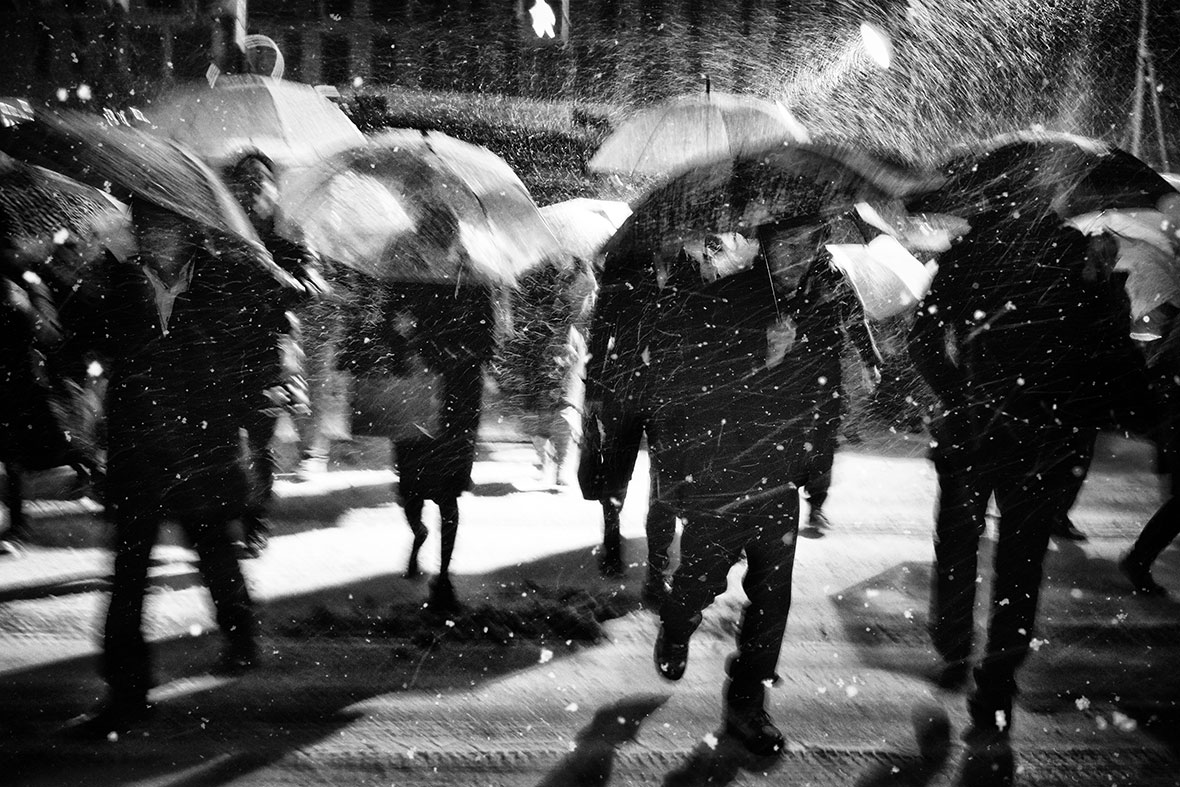
The people filling Kawaoto’s photos are vulnerable, guarded, mysterious, and forgotten. Whatever they are, they’re overstated in their expressions, captured at the peak of their feelings. Personal expression in a public space amplifies everything. It happens regardless of people’s surroundings or because of them. It happens unconsciously or because someone is spilling over and can’t hold it back. When it happens, it’s magic. And Kawaoto is there to capture it.
川音真矢照片中的人物脆弱、谨慎、神秘、不起眼。形形色色的行人,他们的表情都被镜头放大,往往抓拍在情绪最强烈的一刻。在公共空间中的个人表达令一切显得更加醒目。这些情绪的产生或与周围环境无关,又或因环境而起;有的是无意识下的流露,有的是则是因为情难自禁。这样的瞬间有着奇妙的魅力,也是川音真矢一直等待捕捉的瞬间。
Like our stories? Follow us on Facebook and Instagram.
Instagram: @ashley_designing
Contributor: Mike Steyels
Chinese Translation: Olivia Li


